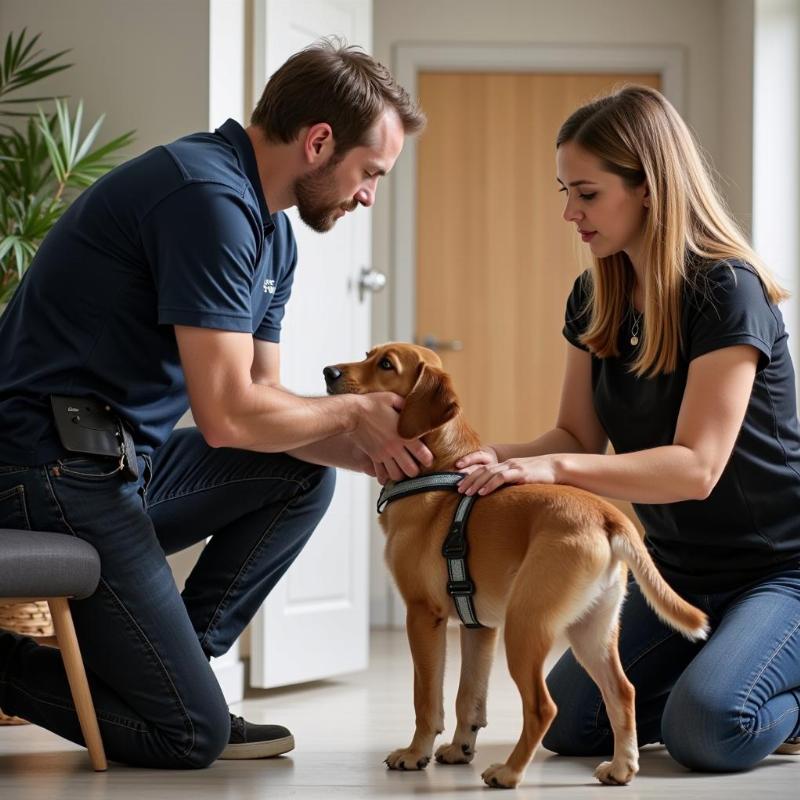Getting a small dog to wear a harness can sometimes feel like wrestling a greased piglet. Many small dogs resist harnesses, and if you’re struggling with a “small dog who will not put on a harness,” you’re not alone. This article will guide you through the process of harness training your small dog, covering everything from choosing the right harness to positive reinforcement techniques.
Choosing the right harness for your small dog is crucial. A poorly fitting harness can be uncomfortable and may even cause injury. For small breeds, consider a step-in harness or a vest-style harness. Step-in harnesses are easy to put on, while vest harnesses distribute pressure evenly across the chest and back, providing extra comfort and support. Avoid harnesses that put pressure on the delicate trachea of small breeds. Measure your dog carefully before purchasing a harness to ensure a snug but comfortable fit.
Positive reinforcement is key to successful harness training. Start by introducing the harness slowly. Let your dog sniff it, and reward them with treats and praise. Next, try briefly putting the harness on, rewarding them immediately, and then taking it off. Gradually increase the duration of wear, always associating the harness with positive experiences.
What if your small dog continues to resist? Patience and persistence are essential. Never force the harness on your dog, as this can create fear and anxiety. Instead, try using high-value treats, like small pieces of cooked chicken or cheese, to coax your dog into the harness. Make the process fun and rewarding, and your dog will eventually learn to associate the harness with positive experiences.
Choosing the Right Harness for Your Small Breed
The variety of harnesses on the market can be overwhelming. For small breeds, focus on comfort, safety, and ease of use. soft dog harness for small dogs are often a good choice, as they’re gentle on delicate skin. Consider the dog’s activity level as well. A highly active dog may benefit from a more secure harness with multiple points of adjustment.
Harness Types for Small Dogs
- Step-in Harnesses: Easy to put on, ideal for puppies or dogs who are new to harnesses.
- Vest Harnesses: Provide good support and distribute pressure evenly.
- H-Harnesses: A basic style, suitable for calm, well-behaved dogs.
Avoid harnesses that restrict movement or put pressure on the neck. A properly fitted harness should allow your dog to move freely and comfortably.
Training Tips for Harness-Resistant Dogs
Introducing the harness gradually and using positive reinforcement techniques are essential for a successful training experience.
Step-by-Step Harness Training
- Introduction: Let your dog sniff and investigate the harness. Reward them with treats and praise.
- Brief Wear: Put the harness on for a few seconds, reward your dog, and then remove it.
- Gradual Increase: Slowly increase the duration of wear, rewarding your dog frequently.
- Associate with Walks: Once your dog is comfortable wearing the harness, attach the leash and begin short walks.
Addressing Common Harness Challenges
What if your dog still refuses to wear a harness? Here are some additional tips:
Troubleshooting Harness Issues
- Check the Fit: Ensure the harness is properly adjusted and not too tight or too loose.
- Use High-Value Treats: Offer irresistible treats to encourage your dog to accept the harness.
- Distraction Techniques: Try putting the harness on while your dog is distracted by a favorite toy.
- Seek Professional Help: If you’re struggling, consult a certified dog trainer or behaviorist.
 Dog Trainer Helping with Harness
Dog Trainer Helping with Harness
Conclusion
Harness training a small dog who resists can take patience and persistence, but with the right approach and a positive attitude, you can successfully teach your small dog to love their harness. Remember to choose the right harness for your dog’s size and breed, and focus on making the experience positive and rewarding. A well-fitted harness is essential for your dog’s safety and comfort on walks, and with a little effort, you can ensure a pleasant walking experience for both you and your furry friend.
FAQ
- My dog chews on their harness. What should I do? Try distracting your dog with a chew toy or using a bitter apple spray on the harness.
- What type of harness is best for a small dog who pulls? A front-clip harness can help discourage pulling.
- How tight should a harness be on a small dog? You should be able to fit two fingers comfortably between the harness and your dog’s body.
- Can I leave a harness on my dog all the time? It’s generally not recommended to leave a harness on a dog all the time, as it can rub and irritate their skin.
- My dog seems scared of the harness. What should I do? Introduce the harness slowly and use positive reinforcement to build positive associations.
- Are there any harnesses specifically designed for small breeds? Yes, many brands offer harnesses designed specifically for small dogs, often with features like lightweight materials and extra padding.
- How can I tell if my dog’s harness fits correctly? The harness should be snug but not restrictive, allowing your dog to move freely and comfortably.
Beautdogs.us is your premier online resource for all things dog-related in the USA. We provide expert advice on dog breeds, care, and lifestyle, offering valuable insights for both new and experienced dog owners. From choosing the right harness to understanding breed-specific needs, Beautdogs.us is your trusted source for comprehensive and engaging dog care information. Contact us today for personalized support! Email: [email protected], Phone: +1 501-555-7529. Visit Beautdogs.us for more helpful tips and expert advice.